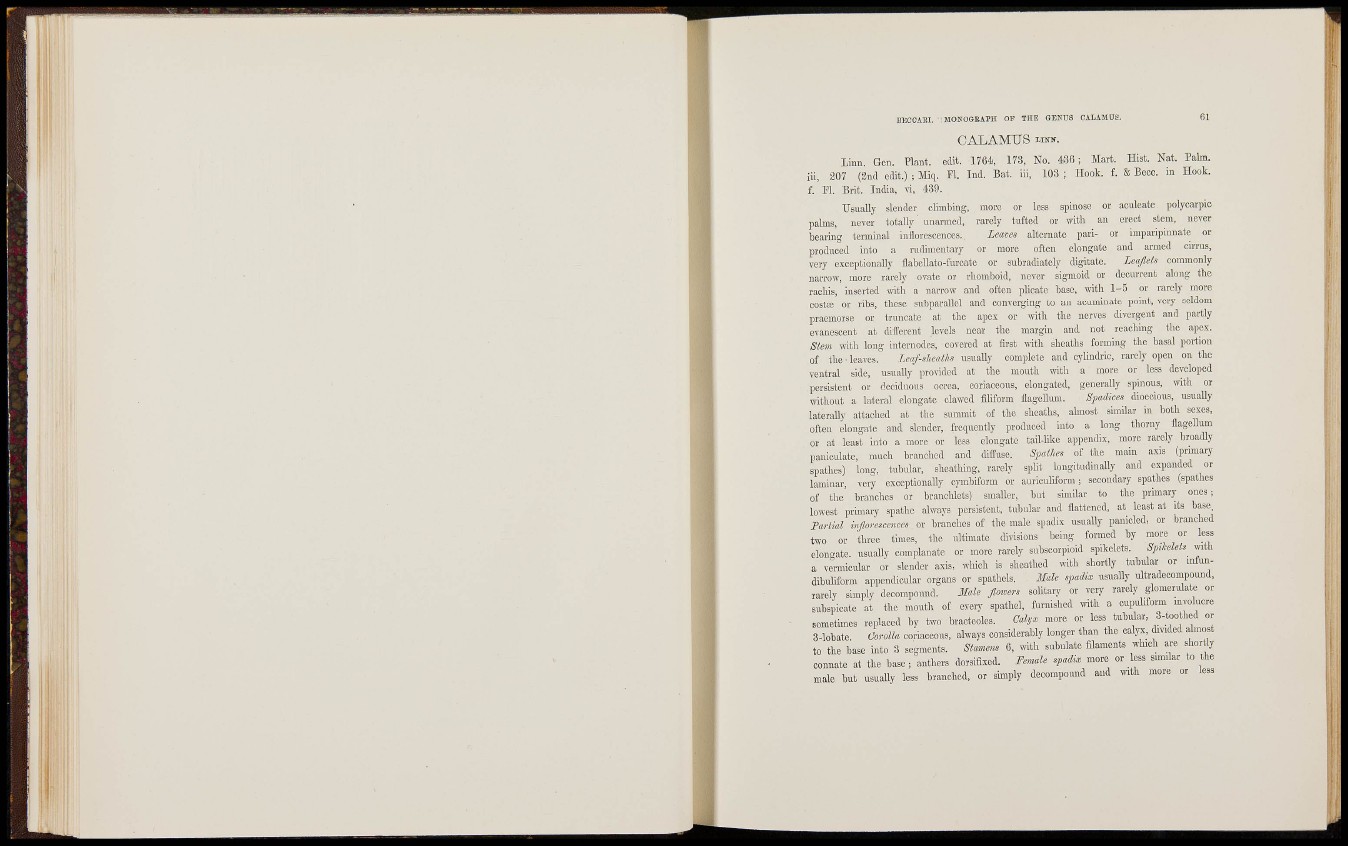
BÏCCAEI. MONOGSIPH OF THE GEIina CALAMOS. 61
O A i A M X r S OTN.
Linn. Gen. Plant, edit. 1764i, 173, No. 436; Mart. Hist. Nat. Palm,
iii, 207 (2nd edit.) ; Miq. H. Ind. Bat. iii, 103 ; Hook. f. & Becc. in Hook,
f. B. Brit. India, ri, 439.
Usually slender cUmbing, more or less spinose or aculeate polyoarpic
pahns, never totally' unarmed, rarely tufted or with an erect stem, never
bearing terminal inflorescences.. Leaves alternate pari- or imparipinnate or
produced into a rudimentary or more often elongate and armed cirrus,
very exceptionally flabellato-furcate or subradiately digitate. LmJleU commonly
narrow, more rarely ovate or rhomboid, never sigmoid or decurrent aloirg the
rachis, inserted with a narrow and often plicate base, with 1-5 or rarely more
costse or ribs, these subparallel and converging to an acuminate point, very seldom
praemorse or truncate at the ape.x or with the nerves divergent and partly
evanescent at different levels near the margin and not reaching the apei.
Stem with long internodes, covered at first with sheaths forming the basal portion
of the • leaves. Leaf-sheaths usually complete and cylindiie, rarely open on the
ventral side, usually provided at the mouth with a more or less developed
persisteirt or deciduous ocrea, coriaceous, elongated, generally spinous, with or
without a lateral elongate clawed filiform flagoUnm. Sfaiices dioecious, usually
laterally attached at the simnnit of the sheaths, abnost similar in both sexes,
often elongate and slender, freciuently produced into a long thorny flagellum
or at least into a more or less elongate tail-like appendix, more rarely broadly
paniculate, much branched and diffuse. Sfalhes of the main ans (primary
spathes) long, tubular, sheathing, rarely split longitudinally and expanded or
laminar, very exceptionany cymbiform or auriculiform ; secondary spathes (spathes
of the' brandies or branchlets) smaller, but similar to the primary ones;
lowest primary spathe always persistent, tubular and fiattened, at least at its base
Partial Mhreseenees or branches of the male spadix usually panicled, or branched
two or three times, the ultimate divisions being formed by more or less
elongate, usually eomplanate or more rarely subseorpioid spikelets. Spúelets mth
a vermicular or slender axis, which is sheathed mth shortly tubular or mfundibuliform
appendicular organs or spatliels. MaU spadix usuaUy ultradecompound,
rarely sknply deeompound. Male flowers solitary or very rarely glomerulate or
subspieate at the mouth of every spathel, furnished with a cupnUform involucre
sometimes replaced by two braeteoles. Gdyx more or less tubular. 3-too bed or
3-lobate GoroUa coriaceous, always considerably longer than the calyx, divided abnost
to the base into 3 segments. Stamms 6, with subulate filaments which are shortly
connate at the base; anthers dorsiflxed. Rmale spaiix more or less smnlar to the
male but usually less branched, or simply decompound and with more or less